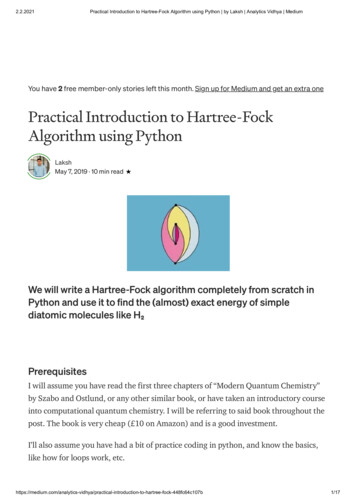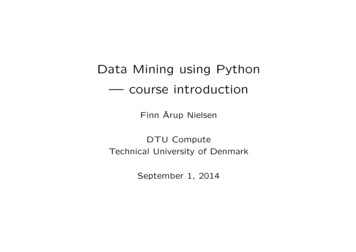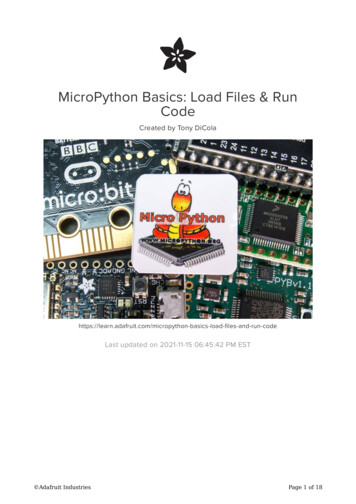
Transcription
2.2.2021Practical Introduction to Hartree-Fock Algorithm using Python by Laksh Analytics Vidhya MediumYou have 2 free member-only stories left this month. Sign up for Medium and get an extra onePractical Introduction to Hartree-FockAlgorithm using PythonLakshMay 7, 2019 · 10 min readWe will write a Hartree-Fock algorithm completely from scratch inPython and use it to find the (almost) exact energy of simplediatomic molecules like H₂PrerequisitesI will assume you have read the first three chapters of “Modern Quantum Chemistry”by Szabo and Ostlund, or any other similar book, or have taken an introductory courseinto computational quantum chemistry. I will be referring to said book throughout thepost. The book is very cheap ( 10 on Amazon) and is a good investment.I’ll also assume you have had a bit of practice coding in python, and know the basics,like how for loops work, introduction-to-hartree-fock-448fc64c107b1/17
2.2.2021Practical Introduction to Hartree-Fock Algorithm using Python by Laksh Analytics Vidhya MediumI will go through the important maths again here and there. This is to function as areminder, and it will not make sense if you are reading about this for the first time. Ifthis is the case, simply refer to the book.In many lines of the code, I will put a page reference to Szabo & Ostlund (I will just refer tothe page number mostly).Advice for following this tutorialI suggest you have a jupyter notebook open, and simply code along. If you don’tunderstand a line of code, test it in another line to pick apart its function.If you get stuck/some code doesn’t workIn this case, I recommend going to my GitHub and downloading the Jupyter Notebookfor this. Then, replace the coding giving an error with the code from the notebook.https://github.com/aced125/Hartree Fock jupyter notebookSummary of the practical stepsOn pp146 of Szabo & Ostlund (I will stop referring to the name of the book from hereon), we will find a summary of the key steps in Hartree-Fock, and go through these.ImportsWe will need some imports for this. Go ahead and install these if you haven’t already.Installing packages in the command lineImports required1a) Specify a molecule (a set of nuclear coordinates, atomicnumbers, and a number of electrons).XYZ files are a common file type to store data about chemical structure. As anexample, take the .XYZ file of ical-introduction-to-hartree-fock-448fc64c107b2/17
2.2.2021Practical Introduction to Hartree-Fock Algorithm using Python by Laksh Analytics Vidhya Medium.xyz file of pyridineLet’s write a function to read in this type of file.We will now read in the XYZ file for introduction-to-hartree-fock-448fc64c107b3/17
2.2.2021Practical Introduction to Hartree-Fock Algorithm using Python by Laksh Analytics Vidhya MediumXYZ file for HeHYou can simply make this file in any text editor (remember to name the file HeH.xyz).Note, we are using the experimentally determined bond length, in atomic units.We will choose the number of electrons in the system later on. We can set this towhatever we like.1b) Specify a basis set. Also, set the number of electrons for thesystem (pp152)We want to represent our Slater-like orbitals as linear combinations of Gaussianorbitals so that the integrals can be performed easily. For a discussion turn to pp152 ofSzabo and Ostlund. In brief, a Gaussian can be specified by two parameters: itscenter, and its exponent. Furthermore, since we are representing slater orbitals as asum of Gaussian orbitals, we need contraction coefficients. The exponents andcontraction coefficients are optimized by a least-squares fitting procedure. Moreinformation here: Hehre, Stewart, Pople, 1969.The zeta coefficients are the exponents of the Slater orbitals, and they have beenoptimized by the variational principle. They are in essence an effective nuclear chargeof an atom. They have been historically estimated using Slater’s rules, which you mightcome across in an undergraduate Chemistry al-introduction-to-hartree-fock-448fc64c107b4/17
2.2.2021Practical Introduction to Hartree-Fock Algorithm using Python by Laksh Analytics Vidhya MediumVariables needed to define the basis setSome more book-keeping is below. Most importantly, here is where we store thenumber of electrons. The storage of atom charges is required for calculation of thepotential energy (although this is not that important per se since the potential energyjust raises the overall energy by a constant value).Some more book-keeping2. Computing all the required integrals in the Gaussian basis2.1) Writing definitions for integrals between the Gaussian functionsWe want to form the Fock matrix in the basis of our atomic orbitals. But our atomicorbitals are a linear sum of Gaussian orbitals. The integrals between individualGaussian orbitals can be calculated easily and their derivations are given in the back ofthe book (pp410).2.2) The product of two Gaussians is a Gaussian (pp410)This lovely property allows easy calculation of integrals. Let’s write a function thattakes in two Gaussians and spits out a new ical-introduction-to-hartree-fock-448fc64c107b5/17
2.2.2021Practical Introduction to Hartree-Fock Algorithm using Python by Laksh Analytics Vidhya MediumThe product of two Gaussians is Gaussian. The proof is straightforward and is left to the reader as anexerciseCode implementationNote that in our code, we have absorbed the normalizing factors into K, and thus donot need to worry about normalisation.2.3) The Overlap and Kinetic integrals between two Gaussians al-introduction-to-hartree-fock-448fc64c107b6/17
2.2.2021Practical Introduction to Hartree-Fock Algorithm using Python by Laksh Analytics Vidhya MediumOverlap and kinetic energy integrals2.4) The Potential integral, the Multi-electron Tensor and Boys Integral(pp412)To get the potential integral and multi-electron tensor, we need to define a variant ofthe Boys function, which in turn (for this case) is related to the error function.Fo functionFor higher orbitals (2p, 3d, etc) we can’t express the Boys function in terms of the errorfunction and different methods are required. This has been subject to great academicstudy. Carrying on, we can now give the potential and multi-electron 7
2.2.2021Practical Introduction to Hartree-Fock Algorithm using Python by Laksh Analytics Vidhya Mediumpotential and multi-electron integrals3. Computing integrals in the atomic orbital basisThis is probably the trickiest part of this tutorial, and care needs to be taken thinkingabout the for loops. The idea is that at each stage of the for loop, we store informationso that we don’t have to keep calling the same things over and over again. It doesn’tmatter here, because we are doing a very simple calculation. But it would matter formore expensive calculations.We will iterate first through the atoms. On each atom, we iterate through its orbitals.Finally, for each orbital, we iterate through its three Gaussians. We perform this tripleiteration over each atom.In this simple case, we could have just summed over the three Gaussians on each atomdirectly (because each atom has only 1 atomic orbital). But by doing it this way, we caneasily extend our program to solve more complicated molecules, which we will do in afuture tutorial.Visual depiction of ntroduction-to-hartree-fock-448fc64c107b8/17
2.2.2021Practical Introduction to Hartree-Fock Algorithm using Python by Laksh Analytics Vidhya MediumThe different summations we are carrying out. Note, for the multi-electron integral we would need to carryout double the amount of sums, that is, 12 sums.You might need to spend some time convincing yourself of this, or (even better) try tocode it out ical-introduction-to-hartree-fock-448fc64c107b9/17
2.2.2021Practical Introduction to Hartree-Fock Algorithm using Python by Laksh Analytics Vidhya MediumNote the extra sum over atoms to get the entire potential energy matrixWe carry out the iteration 2 more times to get the multi-electron l-introduction-to-hartree-fock-448fc64c107b10/17
2.2.2021Practical Introduction to Hartree-Fock Algorithm using Python by Laksh Analytics Vidhya MediumIf you got through that, great! The rest of the algorithm is relatively straightforward.Lastly, since the kinetic and potential energy integrals aren’t affected by the iterativeprocess, we can just assign a variable to the sum of them, Hcore.Hcore4. Symmetric Orthogonalisation of the Basis (pp144)If we remember the Hartree-Fock equations in a basis (the Roothan equations), wecannot solve it like a normal eigenvalue equation due to the overlap matrix.The Roothan EquationsWe can, however, transform into an orthogonal basis. There are several ways to find amatrix that will orthogonalize the basis set but we will use symmetricorthogonalization. We note that since S is Hermitian (symmetric in the case of realorbitals), S can always be diagonalized, the proof of which is in any linear algebra text.We can write:Diagonalisation of the overlap matrixwhere s is a diagonal matrix. Then we can define:It is easy to show -introduction-to-hartree-fock-448fc64c107b11/17
2.2.2021Practical Introduction to Hartree-Fock Algorithm using Python by Laksh Analytics Vidhya MediumIf we then rotate our orbital matrix with X we obtain:Substituting the above into the Roothan equations yields:Left multiplying with the Hermitian-transpose of X we obtain:whereNow we can easily solve the Roothan equations by diagonalizing F’. Below is a codeimplementation to obtain X.Symmetric orthogonalization5. The Hartree-Fock AlgorithmWe are finally in a position to write the iterative algorithmThe reason why Hartree-Fock is iterative is that the Fock matrix depends on themolecular orbitals. That is to say, you can’t get the answer without the answer. Ofcourse, you can take a guess at the answer, and solve the Roothan equations. Thesolution you get will be better than your previous guess. roduction-to-hartree-fock-448fc64c107b12/17
2.2.2021Practical Introduction to Hartree-Fock Algorithm using Python by Laksh Analytics Vidhya MediumIn order to quantify when we stop making more guesses, we can see how the orbitalmatrix has changed compared to the last guess. This is completely valid, but it turnsout that, probably due to convention, we use the density matrix instead (pp138).The density matrixOne really important thing about the density matrix is to remember the sum is onlyover the occupied orbitals (in the closed shell case). It can, thus, be interpreted as abond order matrix as well. Let’s write a function to check the difference between thetwo most recent guesses of the density matrix.Function to check convergenceWe can now initiate a while loop that keeps repeating until convergence.5.1 Take a guess at PWe’ll use the identity as a guessRemember that we’ve defined B as our basis-set size, which is 2 in this case. We willalso store the subsequent guesses of P to see how fast we converge.5.2 Initiate the while introduction-to-hartree-fock-448fc64c107b13/17
2.2.2021Practical Introduction to Hartree-Fock Algorithm using Python by Laksh Analytics Vidhya MediumLoading 5.3 Compute the Fock matrix with the initial guess of P (pp140–141)Calculate G, then calculate FockOne qualm that the hawk-eyed might wonder is why only 1 instance of P comes out ofthe sum in G(and not twice, or even at all). This is because we want to find F in thebasis of atomic orbitals. The coulomb and exchange operators are defined in the basisof molecular orbitals which we must expand in terms of our atomic basis. If theoperators were defined in the atomic basis, we would not need any instance of P.5.4 Symmetric Orthogonalisation, as discussed beforeNote this is part of the while loop. Make sure your indentation is correctThe second block of code is to make sure the eigenvalues, and orbital matrix, is sortedin ascending order. This is not the case by default (for some reason) and so if this partis ignored, the density matrix will be computed wrongly in the next part.5.5 Form the new Density matrix and check for /17
2.2.2021Practical Introduction to Hartree-Fock Algorithm using Python by Laksh Analytics Vidhya MediumAlmost done!Note the use of the convergence-checking function we wrote earlier. If we haveconverged, the while loop will break and we can simply read off our energies andorbital matrix.5.6 Print results and we are done!We can go ahead and enter this:Note the two different types of string formatting: you can use anyThe result (if everything has gone correctly) should be this:Hurrah!You might be wondering why the anti-bonding orbital is still negative? That’s becausewe haven’t added nuclear-nuclear repulsion. We can do that al-introduction-to-hartree-fock-448fc64c107b15/17
2.2.2021Practical Introduction to Hartree-Fock Algorithm using Python by Laksh Analytics Vidhya MediumNuclear repulsionWe can see the anti-bonding orbital is raised in energy a lot more than the bondingorbital is lowered. This is especially so because the species is positively charged, butapplies less strongly in the general case.End Notes:Thanks for following through. Leave a comment if you got stuck anywhere and I’ll tryto answer it. In the next tutorial, we will see what other properties we can obtain otherthan just the orbital energies (population analysis, dipole moment, etc.). In the tutorialafter that, we will see what the main issue with Hartree-Fock is, and how we canimprove on its predictions with second-order perturbation theory (Moller-Plessettheory). In the tutorial after that, we will see how to treat p and d orbitals. Combinedwith this, we can calculate the electronic structure accurately of much larger organicmolecules.Sign up for Analytics Vidhya News BytesBy Analytics VidhyaLatest news from Analytics Vidhya on our Hackathons and some of our best articles! Take a lookYour -introduction-to-hartree-fock-448fc64c107b16/17
2.2.2021Practical Introduction to Hartree-Fock Algorithm using Python by Laksh Analytics Vidhya MediumGet this newsletterBy signing up, you will create a Medium account if you don’t already have one. Review our Privacy Policy for more informationabout our privacy practices.Machine LearningChemistryQuantum MechanicsQuantum PhysicsComputational ChemistryAbout Help LegalGet the Medium ntroduction-to-hartree-fock-448fc64c107b17/17
2.2.2021 Practical Introduction to Hartree-Fock Algorithm using Python by Laksh Analytics V idhya Medium .










